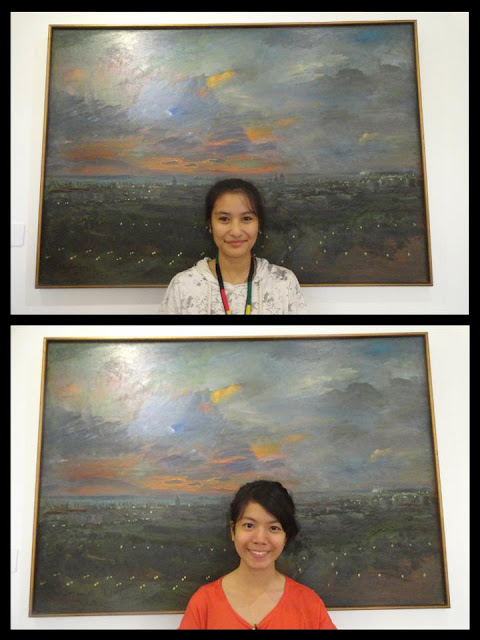Bataan Death
Marcher
Gene Cabrera
Metal and
Wood
Undated
National
Museum Collection
Meaning of the Work: To show that a lot
of Filipinos and Americans died during the Bataan death march.
Although there were survivors, 10000 to 11000 died during the march. It also
show how painful the marchers suffered and how brutal the Japanese soldiers were.
Basic Semiotic
Plane: Gene Cabrera used metal and wood for his work which is 3d in appearance.
Contribution
(“Soul of the Society”): The work contributes to the soul of the society by
showing the pain and trials of those whose were at the Bataan Death March. How
they struggled to fight for the freedom of the Philippines from the Japanese.
Various
Drawings and Studies
Fernando C.
Amorsolo
Graphite on
Paper
Undated
National
Museum Collection
Artist
background: Artist
background: Fernando Amorsolo was born on May 30, 1892 in Calle
Herran in Paco, Manila to Pedro
Amorsolo and Bonifacia Cueto.
Although born in the nation’s capital, Amorsolo would spend most of his
childhood in the small town setting of Daetin Camarines
Norte where his love for the simple rural
life would become the foundation for his artistic output for which he is most
well-known. Amorsolo drew sketches and sold them for 15 centavos a piece to help his family and to pay for his schooling. Despite the family's financial difficulties, in 1914, he finally earned his degree, with honors, as a member of the first graduating class of the University of the Philippines School of Fine Arts.
Meaning of the Work: To show how Fernando Amorsolo started before he really did paintings.
Basic Semiotic
Plane: Fernando Amorsolo used graphite papers, drawing materials like pencil
and colored pencils to do his sketches. His used curvy lines in which grace and
beauty were presented.
Hills of
Nikko
Jose Joya
Oil on Canvas
1964
National
Museum Collection
Artist Background: Jose Joya is a painter and multimedia artist
who distinguished himself by creating an authentic Filipino abstract idiom that
transcended foreign influences. Most of Joya’s paintings of harmonious colors
were inspired by Philippine landscapes, such as green rice paddies and golden
fields of harvest. His use of rice paper in collages placed value on
transparency, a common characteristic of folk art. The curvilinear forms of his
paintings often recall the colorful and multilayered 'kiping' of the Pahiyas
festival. His important mandala series was also drawn from Asian aesthetic
forms and concepts.
Basic Semiotic
Plane: Jose Joya used oil paint in canvas. He used straight and diagonal lines
which represents logical order, discipline, and passion. The color used are
pleasing to the eyes, joyful color that represents peace and quiet.
Meaning of
the work: It is the artist’s interpretation of one of the existing hills in
Nikko, Japan. During wintertime, the hill’s imperfections are thoroughly
covered by snow. However, during summertime, those imperfections are expressed
by the artist in terms of bold brush strokes and super-imposition of lines.The
painting is actually an allegory to human imperfections. The earth colors
symbolize the weaknesses and limitations of humanity while the hues of greens
and blues represent life and hope. The white background represents the snow
that starts to envelop the mound. In the process, the entire imperfection will
be covered thus presenting the cycle of life.
Contribution
(“Soul of the Society”): The work contributes to the soul of the society by how
colourful and peaceful life could be. There may be challenges that people will
face but in the end, when faced with determination to finish or solve that
problem, life will be joyous.
Rape and
Massacre in Ermita
Diosdado M.
Lorenzo
Oil on
Canvas
1947
National
Museum Collection
Meaning of the Work: To show that a lot
of Filipinos and Americans died during the Bataan death march.
Although there were survivors, 10000 to 11000 died during the march. It also
show how painful the marchers suffered and how brutal the Japanese soldiers were.
Basic Semiotic
Plane: Diosdado Lorenzo used oil paint in canvas. He used s diagonal lines
which represents passion and energy. The color used are ‘bold’ which makes that
work ‘lively’.
Contribution
(“Soul of the Society”): The work contributes to the soul of the society by showing
the struggling in times of hardships. Many Filipinas were raped those times and
many babies experienced being bayoneted.
Sunset in
Intramuros
Federico
Alcuaz
Oil on
Plywood
1979
GSIS
Collection
Artists
Background: Born in
June 6, 1932 in Manila City, Federico was the sixth of eleven children and took
his primary and secondary education at public schools. He pursued Associate of
Arts degree at San Beda College in the evenings and a Fine Arts degree at the
University of the Philippines (UP) in the mornings. Among his professors at UP
were National Artist Fernando Amorsolo (painting) and National Artist Guillermo
Tolentino (sculpture) as well as other pillars of Philippine art, such as
Toribio Herrera, Ireneo Miranda and Constancio Bernardo.
Meaning of the Work: Shows how quiet but
mysterious of Intramuroz dues to the darkness of the work.
Basic Semiotic
Plane: Federico
Alcuaz used oil paint in plywood. He used s diagonal lines which represents passion.
The colors used are dark which makes that work sad and quiet.
Contribution
(“Soul of the Society”): The work contributes to the soul of the society by showing
how significant Intramuros to the Philippine history.





No comments:
Post a Comment